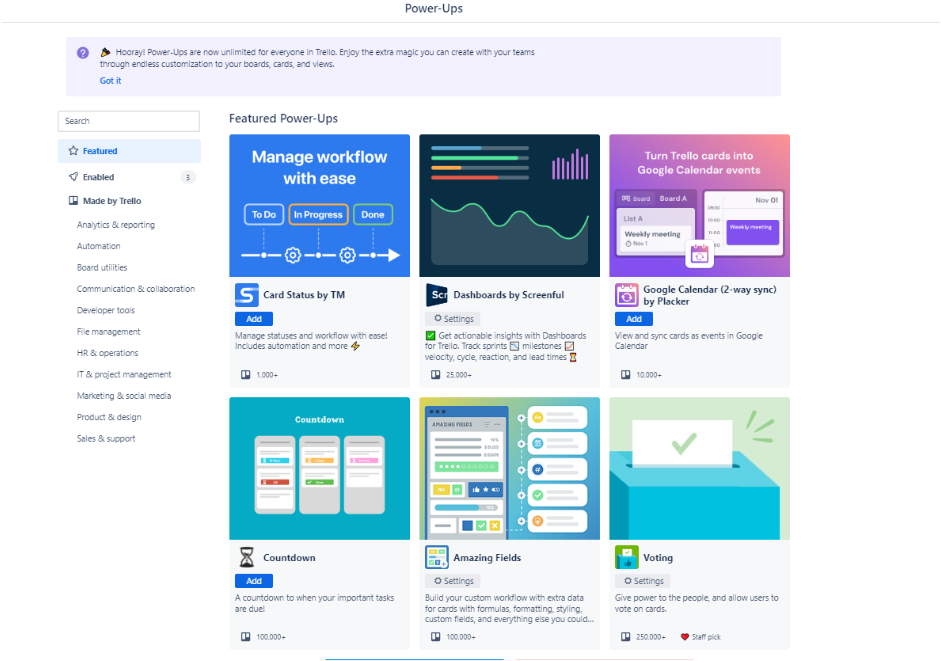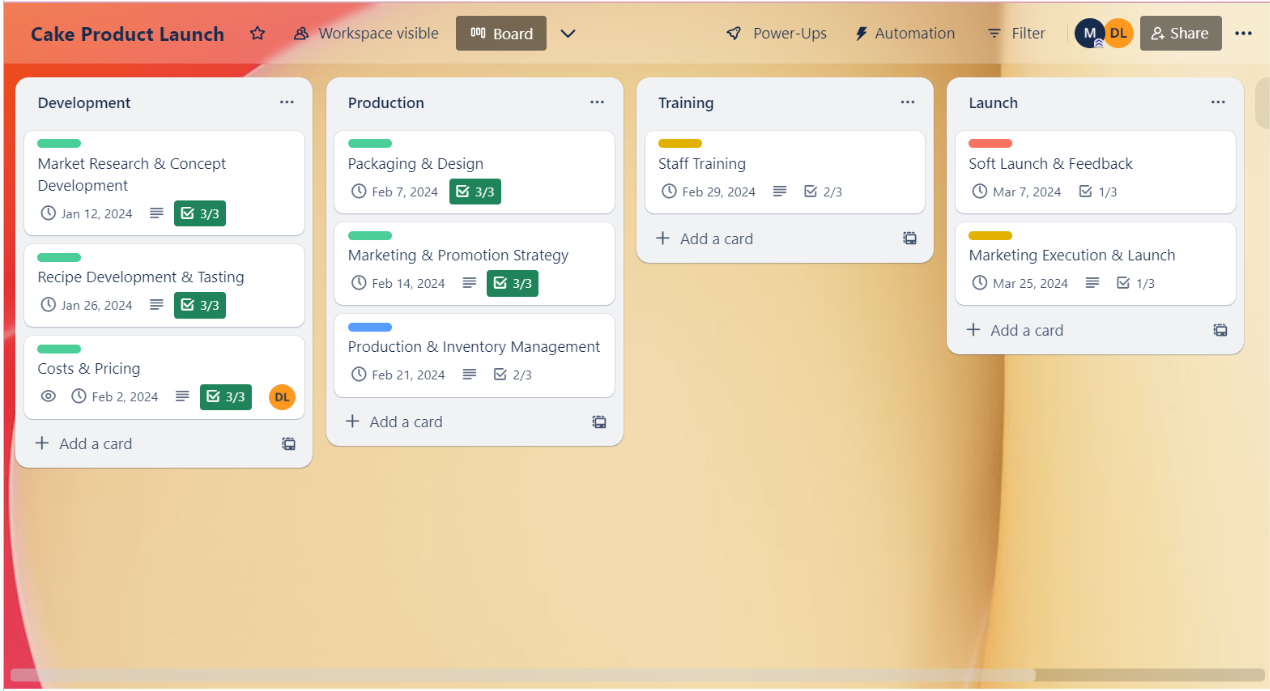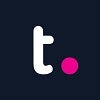Our content is funded in part by commercial partnerships, at no extra cost to you and without impact to our editorial impartiality. Click to Learn More
Trello pricing starts at $5 per user, per month, with more expensive plans costing $10 per user, per month and $17.50 per user, per month. However, there’s also a free plan available if you don’t want to pay anything at all for project management software.
Trello also has a free forever option with no user limit, a range of industry-specific project templates, a Kanban board, and an automation builder. However, it still misses key project management features like a Gantt chart, a project message board, and a dashboard feature for displaying data. While the free plan is limited, Trello scored well on our recent ease-of-use tests and is a relatively simple program compared to the likes of monday.com.
In this guide, you’ll find everything you need to know about Trello pricing plans, its features, and hidden costs. We’ll also discuss cheap Trello alternatives like Teamwork in case you aren’t keen on this particular project management platform.
| Price (annually) The amount you'll pay per month, when billed annually | Users | Projects/Boards | Number of automations | Kanban Board | Gantt Chart | Resource management | Time Tracking | ||
|---|---|---|---|---|---|---|---|---|---|
| Trello Free | Trello Standard | Trello Premium | Trello Enterprise | ||||||
| Free | $5/user/month | $10/user/month | $17.50/user/month | ||||||
| Unlimited | Unlimited | Unlimited | Unlimited | ||||||
| 10 | Unlimited | Unlimited | Unlimited | ||||||
| 250/month | 1000/month | Unlimited | Unlimited | ||||||
| | | | | ||||||
| | | | | ||||||
| | | | | ||||||
| | | | |
What Are the Top Trello Alternatives?
Trello achieved a 4.3/5 overall rating on our recent tests. That places it sixth out of the 10 major providers we test regularly, which is a slight improvement on its 2022 score (4.1/5).
This is partly due to its solid security score (4.4/5). It’s also much easier to use than some of the more powerful providers on the market, such as Smartsheet. Additionally, Trello is better value than many Trello alternatives, with its paid plans starting from just $5 per user, per month.
When it came to functionality, we awarded Trello a score of just 2.6/5. This was the second-worst score any of the ten providers achieved for this assessment area. In Trello, there are no task dependencies, milestones, or time-tracking features, a lack of collaboration tools, and nothing to track budgets with.
What’s more, you have to pay extra for add-ons to overcome its feature shortcomings. Here’s a quick look at our top-rated project management software tools that make for good Trello alternatives:
monday.com– Best overall and the easiest to use provider we tested
Teamwork – Best for budget tracking, cheaper than rivals
ClickUp – Best for task management features & best free plan
Smartsheet – Excellent security and reporting features
It might not have as many features as Teamwork or monday.com, but Trello scores particularly highly for customer support (5/5). The provider offers onboarding, phone, and 24/7 live support on its Enterprise plan. On the other hand, Trello’s 4.1/5 score for ease of use – the fourth-best score on our tests – is higher than the score ClickUp achieved. Several participants in our testing group found ClickUp a little overwhelming, whereas no one had that experience with Trello.
Trello also achieved a good security score of 4.4/5. Two-factor authentication, single sign-on, and user permissions features available on all plans. Wrike doesn’t offer single sign-on until its Enterprise plan, and Smartsheet only offers 2-factor authentication on its enterprise-focused plan.
Despite Trello’s excellent customer service options, there are better programs out there for managing projects. But read on to find out more about Trello’s pricing plans, and how we research project management software:
| Best For | Price (annually) The amount you'll pay per month, when billed annually | Try Now | |||||||
|---|---|---|---|---|---|---|---|---|---|
 |  | ||||||||
| Trello | Asana | Jira | Basecamp | ||||||
| A simple platform with all the basics that will suit small to medium-sized teams delivering straightforward, liner projects. | Teams of all sizes that want an easy-to-operate platform even non-tech-savvy employees can quickly master. | Small and medium-sized teams that want a feature-rich platform like monday.com but don’t want to spend quite that much. | Teams that want to centralize all of their work operations around one, single platform with powerful collaboration and task management tools. | Medium-sized teams that don’t mind paying a little bit extra for a scalable platform with impressive data display tools. | Wrike is a great option for large businesses, with two plans designed for enterprises and a much wider range of integrations than its rivals. | Teams transitioning away from spreadsheets that want a platform with a familiar feel, as well as useful reporting tools and solid support options. | Tech, software development and engineering teams that want a very cheap yet highly effective platform within which to organize their worfklows. | Small teams that want an affordable alternative to the likes of monday.com and ClickUp and are already familiar with Zoho’s suite of other tools. | Small teams that want a space to make to-do lists and collaborate and don’t need additional project planning or organizational features. |
| $5/user/month | $500 (1-10 users) | $99/month | |||||||
| Compare Deals | View monday.com | View Teamwork | View ClickUp | Compare Deals | View Wrike | View Smartsheet | Compare Deals | View Zoho | Compare Deals |
Trello Test Summary (2024)
I found Trello easy to use. It’s a very basic program compared to other platforms (Asana, ClickUp etc.). I’d recommend it to any team that just needs somewhere to track updates, tasks, and other information for a relatively straightforward project. The customer support options are pretty good too, which is a plus!
However, I started to find Trello quite limited when I needed to perform more complex project management tasks. Automations aren’t easy to build like they are with monday.com. There are also quite a few add-ons you’ll have to purchase and install if you want them to complete other tasks.
If you’re looking for free or basic software for a project and don’t want a truly transformative platform to centralize all your team’s operations around, Trello is perfect. However, if you have some budget reserved for new software and you’d like that sort of team “hub”, I’d recommend Teamwork’s Starter plan or ClickUp’s free plan.

Trello Pricing – Is Trello Free?
Yes. In 2024, Trello offers a 100% free plan and a free trial of its paid tiers. This means you can see if it’s right for your team without paying a penny.
The entire Trello pricing system is easy to understand, so you should be able to find a good fit for your business easily. Below, we’ve listed Trello’s plans for you to compare. You can read on a full guide to the benefits you get for each of Trello’s pricing tiers, as well as how much you’ll need to pay. Trello’s four different plans are:
- Trello Free – best for just getting started, not as good as ClickUp’s free tier.
- Trello Standard ($5 per user, per month) – best for smaller teams that need basic features
- Trello Premium ($10 per user, per month) – best for businesses that need admin control.
- Trello Enterprise ($17.50 per user, per month) – best for enterprise-level organizations.
Trello Costs Explained
It’s no secret that the economy still isn’t firing on all cylinders. So, it’s more important than ever that companies are getting good returns on investment when it comes to software. Trello’s plans are actually very good value for money and among the cheapest on the market. The Standard plan represents an excellent option for small teams who can’t fork out big bucks for software.
Trello scores 4.1/5 for pricing on our 2024 tests. Although it’s more limited than some of its rivals in terms of features and functionality, you’re also not paying much for it at all. This means it’ll be more than serviceable if you’re looking for a basic task-tracking tool with a few handy features, rather than a completed Work OS for centralizing all of your business’s planning and communication. If you do want that, you may feel a little shortchanged with Trello.
Only 46% of organizations make project management a cultural priority, and 11.4% of all resources are wasted due to deficiencies in project management methods. Right now, it’s a good chance to get ahead of the game, and Trello can certainly help you with that. Below we’ve explained the provider’s pricing plans in detail.
Trello Free plan – Best for individuals just getting started
As we mentioned earlier, Trello pricing starts with a free plan. Trello’s Free plan has unlimited personal boards (viewable only by a single individual) and 10 boards (projects) per workspace. Other features in the free plan include:
- Unlimited cards (i.e. tasks)
- Unlimited lists
- 10MB per file attachment on task cards
- Unlimited power-ups
The free tier does come with limits though. There aren’t any data visualization tools on Trello’s free plan, or many collaboration features either. This is one of the reasons why it’s better suited for individuals. It’s quite some distance off being as useful as ClickUp’s free offering, which offers a wealth of collaboration features and data visualization tools for absolutely nothing.
Both ClickUp and Trello let users create automations on their respective free plans. This is a big plus for project managers who want to boost efficiency without spending a dime.
Trello Free plan users will also have access to Agile project templates and you’ll be able to integrate your project management software with Microsoft Teams, Hangouts, Telegram, and Slack as well as CRM software like Pipedrive. As free plans go, it’s pretty good.
Trello Standard plan – Best for smaller teams that like the basic Trello interface
The Standard tier ($5 per user, per month) offers small businesses a more affordable option for project management. However, it still offers core features necessary for professional operations. Additional features include:
- Unlimited project boards
- Advanced checklists
- Ability to add guests
- Custom fields
- 250MB per file attachment on task cards
The ability to add guests and have unlimited project boards is largely why smaller teams will feel more at home than with the free plan, despite not adding that many more features.
A lot of other top project management software providers make many of their features available on their first paid plans. For example, Asana’s free plan offers no data visualization tools such as charts and widgets (just like Trello) but its first paid plan has one of the best sets of tools for presenting data money can buy.
Last year, Trello released Advanced Checklists for its Standard, Premium, and Enterprise plans. Advanced checklists let managers create step-by-step to-do lists for tasks, and subsequently assign staff members and due dates to each item in these to-do lists.
You do miss out on some of the more functional Trello features found in the Premium plan though. You’ll only get access to the standard board view, with no timeline view, table view, dashboard view, or any of the other options available on this plan.
Additionally, you’ll only get standard support, rather than the priority support found in more expensive plans. Still, this is a decent entry-level option that is more affordable and better value than rival standard plans. For example, Wrike’s first plan is almost double the price of Trello’s. monday.com also has a more expensive first paid plan, but a lot of features are still locked away on top tiers, so we’d recommend Trello’s cheaper option.
Trello Premium plan – Best for businesses that need admin control
Going up to the Premium tier will cost $10 per user, per month billed annually. This tier supports the same unlimited personal boards, cards, and lists, but adds a few more features, including:
- Additional views (Timeline, Calendar, Dashboard)
- Admin control
- Security features
- Simple data export
Most importantly, this is the first plan with proper admin control and advanced security features too. This means you can truly manage your larger team in a more meaningful way.
There’s also a Gantt chart for tracking project progress and some preset charts for visualizing data, and milestones so you can see your project’s critical dates. On this plan, you’ll be able to create sub-tasks that branch off main tasks, and there’s that handy calendar we mentioned earlier.
Unfortunately, when compared to a premium plan from the likes of ClickUp, monday.com, or Wrike, Trello still falls short. What’s more, ClickUp’s premium offering, the Business plan, is just $2 more per user, per month than Trello’s Premium plan. ClickUp has a much vaster set of features than Trello offers, so we think it’s worth the small difference in price. Besides, you’ll only end up buying add-ons once if you opt for Trello in this sort of situation, anyway.
On the other hand, if you think another provider might be a better fit for you, check out our monday.com review and Wrike pricing guide.
Trello Enterprise plan – Best for enterprise-level organizations
Finally, there’s the Enterprise tier. This plan has variable pricing depending on the number of team members. To use Trello with 25 Enterprise users — the minimum number of users — you’ll be paying $17.50 per user, per month, billed annually. But this price starts to fall as you add more users.
As well as everything in the Premium plan, Trello Enterprise adds several additional features, including:
- Organization visible boards
- Organization-wide permissions
- Unlimited workspaces
- Multi-board guests
- Attachment permissions
All these features are aimed at enterprise-level organizations. This makes this plan the best option for large businesses that need a certain level of control over the platform and a whole lot of team members.
Trello scores 5/5 for customer support, higher than any other provider we tested. On the Enterprise plan, which is still cheaper than the Business plans provided by the likes of Wrike and Asana (both retail at over $20 per user, per month), you’ll have access to onboarding assistance and 24/7 live support. You’ll also be able to receive guidance over the phone too.
Expert's View
I think Trello works well when it comes to straightforward task management, thanks to a simple interface within which most things can be edited via a click of the mouse. It doesn’t seem to overcrowd its interface with too many buttons either, making navigation easier. However, I’ve found it less useful when it comes to managing the more complex aspects of running a project. For example, I couldn’t find an effective workaround for resource management that doesn’t involve manual work to set up, and users will also face limited options with regard to data visualization.

Trello Pricing: Hidden Costs
Trello doesn’t have as many native features as rivals like ClickUp or monday.com, scoring just 2.6/5 for overall functionality. It scores poorly for data visualization (2.9/5) because there are no tools for displaying data on the free or standard plan. Once you get the Premium plan, there’s a smaller range of chart types (3) than you’ll get if you opt for a provider like monday.com (6). You also can’t pull data through from custom fields for display, either.
It supplements shortcomings like these with an extensive directory of “Power-Ups”. Power-Ups are basically add-ons that are designed to complete specific tasks or allow you to integrate with other software.
However, only about a third of these Power-Ups are completely free or have a free option. This means you’ll have to pay for the rest. This puts Trello’s low price tag into a slightly different perspective; although it’s got a cheaper first paid plan than the likes of Wrike and Asana, you’re much more likely to spend money after you purchase a subscription.
However, if you just need a basic task tracker with a simple interface, you might not need additional features. But in most cases, it’ll be simpler to go with ClickUp, pay the extra couple of dollars, and have everything you need ready to go.
What’s New in Trello in 2024?
It seems that Trello is deploying the “if it ain’t broke, don’t fix it” approach to updating its software. Although it’s now 2024, the last Trello changelog entries were published in June 2023. The last major modification was when Atlassian made a change to how webhooks operate in the application.
Now, it would be wrong to expect Atlassian to be updating Trello all the time. It’s only really suitable for basic project management so doesn’t need lots of improvements, and besides, Atlassian has the more powerful Jira to attend to if it wants to compete with providers like monday.com. If new features were constantly being added to Trello, it might lose its USP.
Aside from the changes from the first half of the year, there are no Trello updates to discuss. However, Atlassian is merging the Trello blog with its Work Life blog. This is where users will now have to go for handy hints and tips to get the most out of the software. Could this be a sign of deep integration with Jira to come? We’ll keep you posted.
Trello Features
Trello users start life on the free tier, which has no limits on personal boards, and a healthy cap of 10 shared boards per workspace. Like Jira, the idea with Trello is that you manage tasks by moving the cards between different lists on your board. What those lists are named is completely up to you.
Task cards might start life in a “Not started” list, before moving over to “In process,” and then finally, “Completed.” As the task cards move through these different stages users simply have to drag-and-drop them to the next list.
The downside of the free tier is that the use of Power-Ups is limited, and many key features needed for project management just aren’t available without that extensibility. Trello also doesn’t have task dependencies, though you can use the site’s linking features to achieve a similar result. It’s also lacking a calendar view and a timeline for seeing all the tasks at once; however, both of those features can be added via Power-Ups.

Pros
- Very easy to get to grips with
- Clean, uncluttered interface
- Great customer support options
- Excellent value, cheap first plan
Cons
- Very limited free option
- Too basic for larger teams
- Relies on paid add-ons too much
- Free plan available

- Standard: $5/user/month

- Premium: $10/user/month

- Premium: $17.50/user/month

Power-Ups
Trello’s third-party integrations and extensions for added functionality are known as Power-Ups. Similar to extensions built for the Chrome and Firefox browsers, Power-Ups can be created and submitted by other Trello users, third parties, or Atlassian itself.
There are tons of Power-Up options such as Butler for task automation, timeline views, Gantt charts, and integrations for popular work tools such as Slack, Google Calendar, Google Drive, and Salesforce. There’s even a voting plug-in if you want to poll your team on a certain issue.

Trello’s Power-Ups portal. Image: Tech.co’s testing process
Unfortunately, as we’ve mentioned already, the main reason Trello users have to rely on a series of Power-Ups is that the software is quite limited, at least when compared to monday.com.
Take collaboration for instance – Trello scores just 1.8/5 and doesn’t include an online whiteboard, project message board, document editing tool, or any AI capabilities. ClickUp, which scores 4.7/5 for collaboration, offers all these features on its free plan (aside from its AI workplace assistant).
Board views
Trello is famous for its board system, allowing users to seamlessly pass through the steps of a project for all to see. From the idea stage to the completed stage, you’ll be able to drag and drop tasks along a Kanban board to keep track of it all:

The Kanban board interface in Trello. Image: Tech.co’s testing process
However, if you opt for the Premium plan, you’ll get access to a wide range of other board views, including calendar, timeline, dashboard, map, and team table, all offer a different look at your team’s progress.
Trello still only scores 2.9/5 for task management, however, because it doesn’t include a resource management tool, team view, or a task dependency function, which means it’ll feel restrictive if you’re running a large-scale project with numerous team members and complex tasks.
Email to task card conversion
Every single team member on a Trello board receives their own personal email address for the board. They can then send an email to the board to add a new task, or forward messages that are then automatically converted to tasks. There could be a board dedicated to filling a specific company position, for example, and then every application received via email could be forwarded to the board.
For each email the subject line becomes the task card name, the written contents of the message become the details view, and any attachments are included as well. It’s a very handy feature and a good way to get information into Trello from multiple places.
Trello video overview: Project management in action
This video from Trello shows the basics of the project management tool including how to navigate the app, and how to organize tasks and lists within boards.
Although Trello is free, the provider also offers free trials of its paid software, so you can take it out for a spin if you’d rather have a proper look at it for yourself!
Is it Easy to Switch to Trello?
Yes. It’s pretty easy to switch to Trello from other project management software. This is because Trello will let you import data from CSV files, and top project management software tools like monday.com and Asana will let you export projects and boards as CSV files. So, you can convert your boards, and then import them into Trello.
After you’ve done that, you’ll be able to crack on with your project. You may have to do a bit of post-migration tinkering, but all of your data will be there for you to access.
Here at Tech.co, we only publish reviews about a product if we’ve road-tested using a professional research framework.
For our 2024 project management testing series, we focused on five different assessment areas to score providers. These were security, functionality, ease of use, customer support, pricing, and integrations. We then broke “Functionality” down into four sub-categories: task management, workflow creation, data visualization, and collaboration.
There are loads of websites out there that say they’ve used a certain software program, or claim they’ve tested it. Software providers also tend to claim their software or service is the best. We try to buck that trend by publishing the results of our research, rather than making claims that aren’t backed up by anything at all.
Finding accurate information about software tools online isn’t always easy. So rest assured that we’ve got you covered. We do have commercial partnerships with some of the providers we write about, but our product-led research allows us to remain editorially independent.
| Ease of Use | Pricing | Customer Support | Functionality | Security | |||||
|---|---|---|---|---|---|---|---|---|---|
| 4.5 | 4.3 | 4.2 | 3.9 | 4.1 | 4.1 | 3.6 | 3.2 | 3.2 | 2.5 |
| 3.9 | 4.4 | 3.7 | 4.4 | 3.7 | 4.1 | 4.2 | 4.8 | 4.6 | 2.8 |
| 4.5 | 3.8 | 4.5 | 3.3 | 4.0 | 5.0 | 4.5 | 3.5 | 2.7 | 2.8 |
| 4.2 | 3.7 | 4.1 | 4.6 | 3.7 | 2.9 | 3.2 | 3.1 | 3.3 | 1.7 |
| 5.0 | 5.0 | 4.4 | 4.3 | 5.0 | 4.4 | 4.4 | 4.2 | 4.8 | 3.3 |
Verdict: Should you use Trello?
Trello is a great tool for anyone who appreciates simplicity and an intuitive drag-and-drop interface, and it’s great for basic task management. The free plan is a good offering and considering you’re not paying anything at all, there’s a very decent slew of features.
Out of 10 project management software tools we tested, however, Trello only came 6th – s0 there are better options out there. Smaller teams on a tight budget who need to get organized will appreciate what Trello offers, but to be completely honest, free plans like Teamwork’s performed much better in our testing, as did their paid plans.
If you need a high level of functionality but still want a software program that’s very easy to use, you should look to monday.com, our top-rated provider. It got the best score on our ease-of-use tests and has a better set of features than Trello. Click the link below to compare project management software now:
Its customer support provision also wasn’t the best, and in these areas, providers like Asana, monday.com, and ClickUp performed a lot more commendably.
If you click on, sign up to a service through, or make a purchase through the links on our site, or use our quotes tool to receive custom pricing for your business needs, we may earn a referral fee from the supplier(s) of the technology you’re interested in. This helps Tech.co to provide free information and reviews, and carries no additional cost to you. Most importantly, it doesn’t affect our editorial impartiality. Ratings and rankings on Tech.co cannot be bought. Our reviews are based on objective research analysis. Rare exceptions to this will be marked clearly as a ‘sponsored’ table column, or explained by a full advertising disclosure on the page, in place of this one. Click to return to top of page










